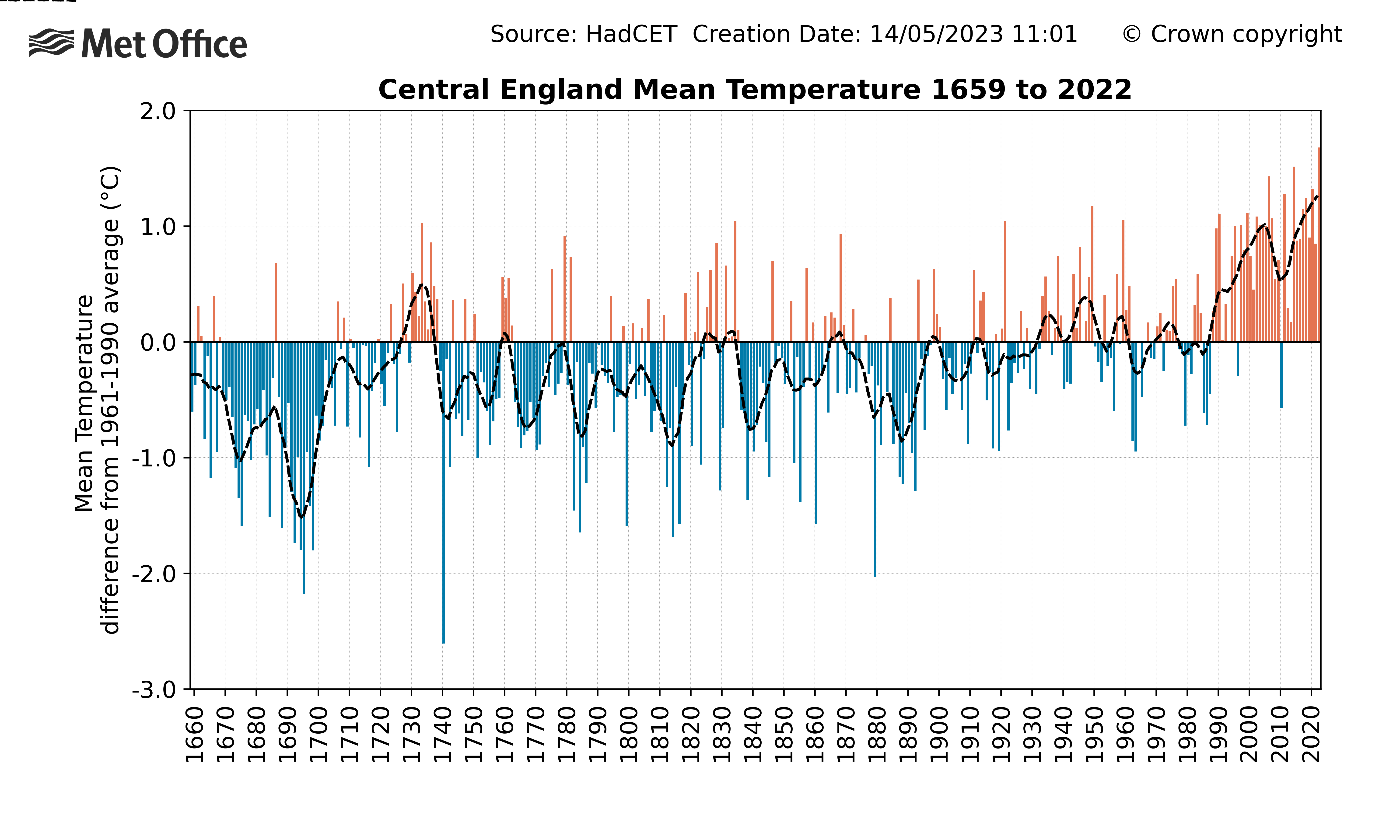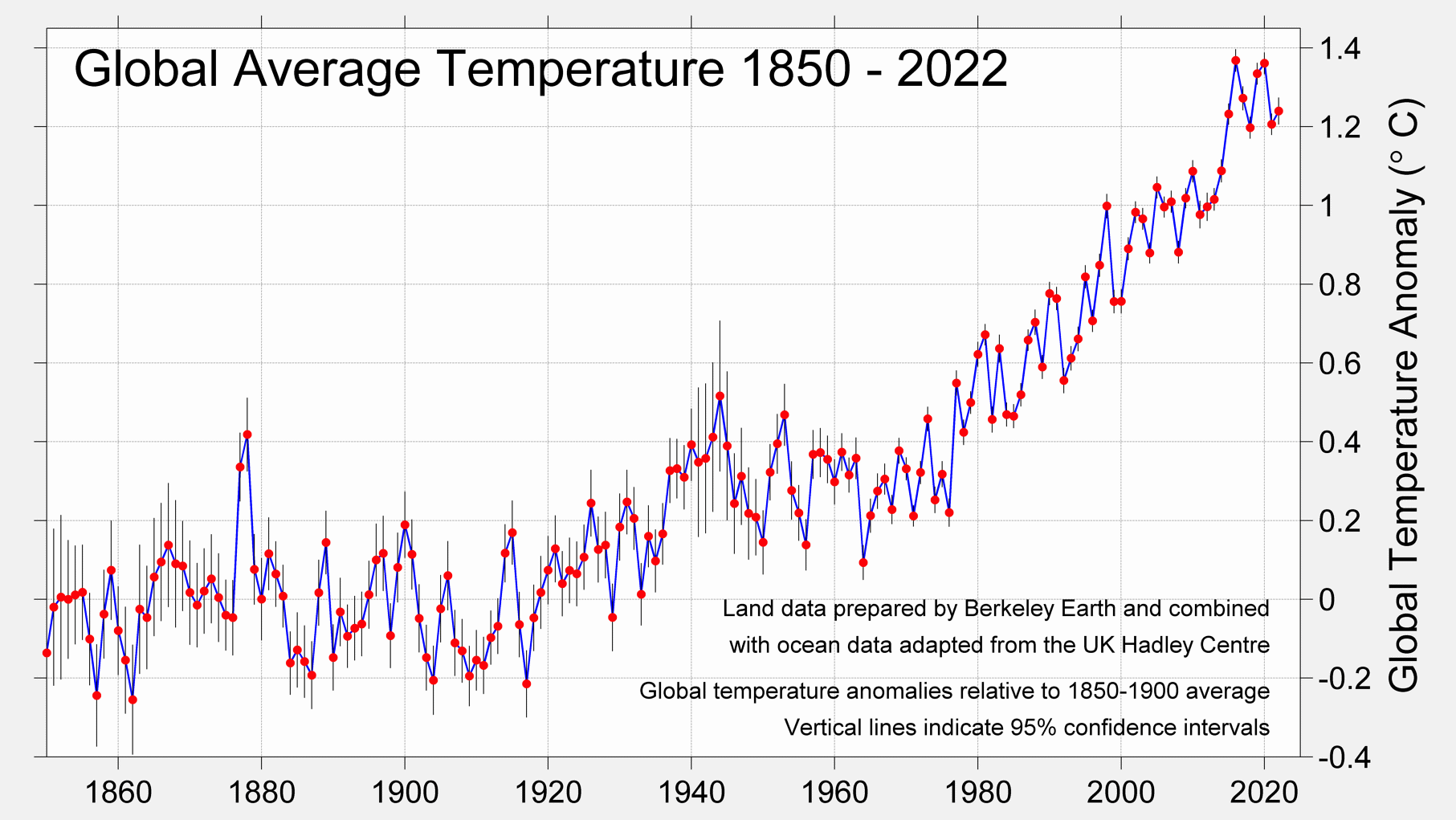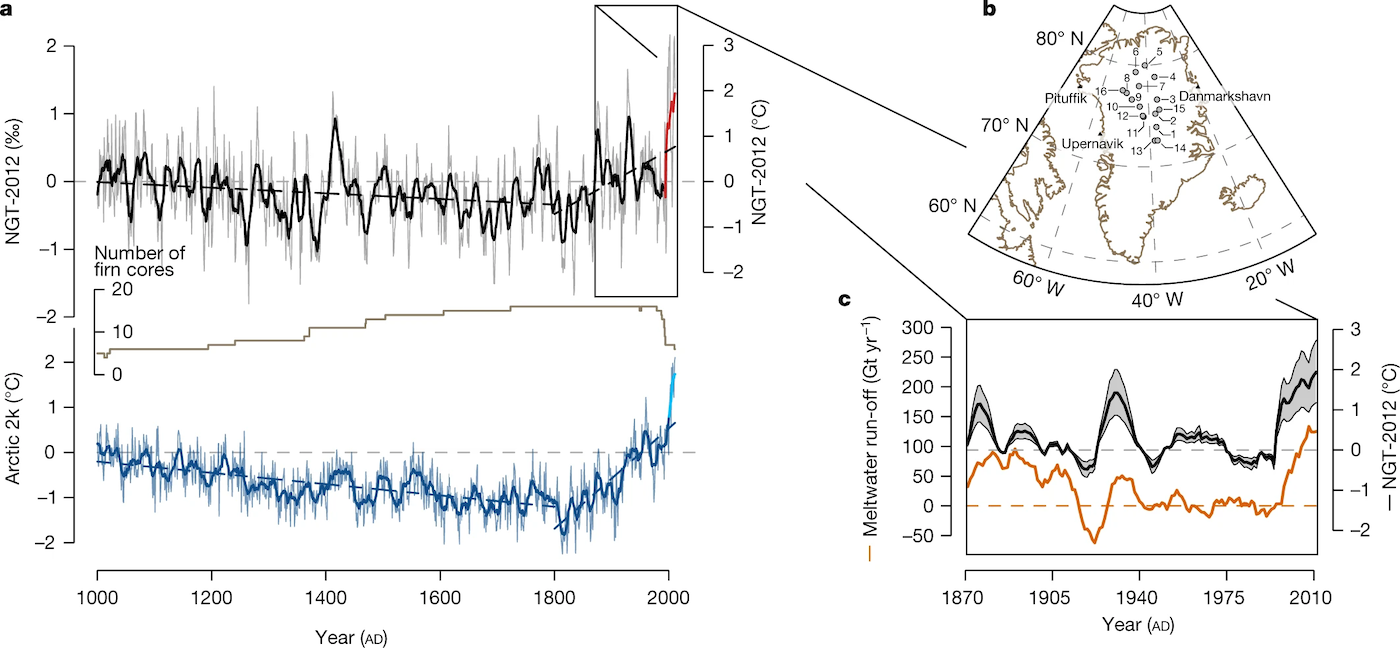
Misleading: The most recent temperature datapoint that the claim references corresponds to 1855, which is misleading since warming caused by humans occurred mostly after this time.

REVIEW
CLAIM: “We have been cooling down for the past 4000 years”; the Earth has cooled since the ‘medieval warming’, “It’s all about when you start the measurements”
Information about Earth’s past climate can provide insights for the trends we are currently experiencing. Historical temperature conditions can be reconstructed from archives such as ice cores and tree rings that contain proxies for temperature. Although records exist of measured temperatures that date back to 1659 (Figure 1), direct records predating the 1880s are too sparse for the purposes of climate studies at a global scale, hence the need to rely on proxies.

Figure 1 – Mean temperature anomalies for each full year in the Central England Temperature series against 1961-1990 climatology. While these data also show temperature increases since the industrial era, they are too sparse for climate studies at a global scale. Source: HadCET (2023)
Ian Plimer, a former mining geologist who has previously made unsupported claims about climate change, recently claimed “we have been cooling down for about the past 4000 years”, implying that this somehow contradicted what scientists know about recent global warming. In the video, Plimer falsely claims that there has been no change in temperature over the past 38 years, in direct contradiction to available data (see Figure 2).
Plimer also claims that the global temperature has been cooling since the “medieval warming”, which he can only conclude by ignoring any data after the 1850s; this claim has previously been debunked on Science Feedback. Figure 3 shows that current temperature increase is happening at higher rates than past changes in climate over the last 2,000 years.

Figure 2 – Global temperature estimates compiled by Berkeley Earth

Figure 3 – Global Warming/cooling rates averaged across 51 years and based on paleoclimate records. Modern thermometer records shown in black. Source: University of Bern
Plimer points to temperature data over almost 10,000 years taken from one ice core extracted from the Greenland Ice Sheet, Greenland Ice Sheet Project 2 (GISP2), citing a 2000 paper[1] by Richard Alley, Professor of Geosciences at Pennsylvania State University. However, this dataset does not capture the past 170 years, which is the period after which the Earth began warming due to human activities. In addition, since the data dates back to the 1990s and was extracted from just one ice core using assumptions that are now questioned and analysis optimized for studies of tens of thousands of years rather than the past two centuries, it is not a suitable reference for discussions of current climate change and more recent data extracted with more modern analysis techniques exist.
“The curve misses the point as it is not showing the context of recent global warming,” Anders Svensson, Associate Professor in Physics of Ice, Climate and Earth at the University of Copenhagen told Science Feedback, pointing out that the time scale shows years before 1950 CE and that the most recent point is 1855. The current rising temperatures due to human activities that are causing concern mostly occurred after 1855.
In response to Plimer’s emphasis on the importance of timeframes temperature comparisons are made within, Maria Hörhold, a senior researcher in the Department for Glaciology at the Alfred Wegener Institute Helmholtz Centre for Polar and Marine Research pointed out that looking at a longer time frame would be more useful for showing the seesaw pattern of temperatures in glacial and interglacial periods. In her own study[2] on more recent analysis to extract temperature data from Greenland ice cores, she and her colleagues also point out that their data show temperatures cooling down until the industrial era hit in the nineteenth century. It is at this point that human activities led to global warming. In addition this is not on a par with the previous rate of cooling but at a much higher rate, as shown in Figure 4 below. NASA’s Earth Observatory website quantifies current warming at 10 times faster than previous warming after the last ice age. “The natural system has cooling and warming”, she told Science Feedback. “That is not under debate, no-one is arguing against that”. However, the fact that climate changed naturally in the past in no way invalidates scientific understanding that current emissions of greenhouse gases by human activities are also causing the global climate to change now.

Figure 4 – The graphs show temperatures for Greenland (NGT, the North Greenland Traverse) taken from ice cores, compared with temperatures from the broader Arctic region (north of 60°N) and measured meltwater run off. It shows how recent warming due to human activities drastically outpaces the previous natural cooling trend. Source: Hörhold et al. (2023)[2]
Temperature data in the recent Nature study[2] by Hörhold and colleagues cover the period 1000-2011 AD and identify a clear warming trend, with temperatures over 2001-2011 exceeding temperatures over any other period in the past thousand years. Temperature reconstructed from tree rings show the same trend[3], and an estimated warming of approximately 1.1°C since the industrial era was reported[4] in 2021 by the Intergovernmental Panel on Climate Change (IPCC) – an organization that synthesizes the best available research carried out by scientists globally.
Data processing challenges
There are numerous challenges in extracting reliable temperature data from ice cores as described at length in this article by Carbon Brief. One of the main issues is the noise, that is, fluctuations in the data that make it harder to identify a trend. This can be local due to wind blowing snow around the surface of the ground before it is compacted into ice, or it can result from natural fluctuations in weather. There are now recognized ways of dealing with this noise for modern day studies that can extract more reliable temperature data that holds for the region from which the ice cores are taken. One approach, as used by Hörhold and colleagues to amplify the signal of any trend in the temperature data over the noise, is to combine the data from several ice cores taken from different points.
“In the data from Cuffey and Clow[5] used in the Younger Dryas paper[1], [that is, the 2000 paper that the graph Plimer cites is taken from] there is some smoothing applied, and, the data shown were optimized to capture the change from ice age to today, not to capture shorter-lived changes more recently,” Alley told Science Feedback, flagging the limitations of the data when looking at shorter time frames. He also notes that despite many reconstructions that have been made for more recent times, this particular misinterpretation “keeps coming back”.
“So, it [the dataset Plimer cites] is not global”, he adds. “It is smoothed in a way that is not best for the purpose of looking at recent changes, it is not the right data set if you are concentrating on recent changes, and it is no longer the most up-to-date data set. Careful scholars simply would not be making any interpretation of recent temperatures based on this old publication.”
As Alley told Andrew Revkin for an article in the New York Times 13 years ago, “using GISP2 data to argue against global warming is, well, stupid, or misguided, or misled, or something, but surely not scientifically sensible.”
Current human activities are causing global warming
Alley also points out that over the course of Earth’s long history spanning hundreds of millions of years, there have been many periods that are hotter than now, so hot that large regions would have been uninhabitable to unprotected humans.
“The high temperatures in those past times were primarily caused by high CO2 levels”, said Alley. “Those were caused naturally, and the warming occurred at much slower rates than what we’re doing. The current rise is not natural, but caused by us.”
Hörhold also highlights how temperature variations correlate with CO2 concentrations. Historic CO2 concentrations can be measured from ice cores too and naturally vary from 280-320 ppm. Looking at global CO2 levels for the past year for instance at CO2.Earth, reveals concentrations around 420 ppm. “Much higher than this natural variation,” adds Hörhold. On account of these increased CO2 concentrations, the historical correlation with temperature, and the increased temperatures in modern day measurements, scientists no longer doubt that we are in a period of global warming due to human activities that emit greenhouse gases like CO2.
Conclusion
In summary, Plimer cherry-picks one old dataset that is a proxy for the temperature at a single point in Greenland to falsely imply that the Earth as a whole has cooled since the ‘medieval warming’ or the past 4000 years. When scientists reconstruct Earth’s surface temperature, they show that global temperatures have warmed rapidly over the past century, largely exceeding the slow and local temperature variations during the ‘medieval warming’ or the little ice age.
SCIENTISTS’ FEEDBACK
Richard Alley, Professor, PennState University:
Scientific studies have shown that, under strong human-caused warming, we could approach or reach temperatures in some places this century that would be fatal for unprotected humans—someone sitting naked in the shade in the wind drinking water would still die of heat stroke. Well before that, impacts of heat likely would drive many people away by stressing them and their crops and farm animals[6,7].
I frequently meet people who say “Climate has always changed naturally, so we should not worry about people changing climate.” I have never met someone who said, “Fires have always occurred naturally, so we should not worry about arson.” I have never met someone who said, “People have always died, so we should not worry about murder.” Climate has always changed, which proves climate is changeable. Climate change has always affected living things, which shows that climate change is important. Climate has changed for many reasons, but especially because of changing CO2, which focuses special attention on our release of CO2 to the atmosphere from fossil-fuel burning and other activities. When authoritative bodies look at the history of climate and use that knowledge to help inform understanding of possible futures, they find that releasing more CO2 to the atmosphere will change the climate in many ways, and these will overall make life harder for humans. Very strong scholarship shows that using this knowledge effectively can help the economy as well as the environment.
REFERENCES
- 1 – Alley (2000) The Younger Dryas cold interval as viewed from Central Greenland Quaternary Science Reviews
- 2 – Hörhold (2023) Modern temperatures in central–north Greenland warmest in past millennium Nature
- 3 – Wilson (2016) Last millennium northern hemisphere summer temperatures from tree rings: Part I: The long term context Quaternary Science Reviews
- 4 – IPCC (2021) Climate change widespread, rapid, and intensifying – IPCC
- 5 – Cuffey and Clow (1997) Temperature, accumulation, and ice sheet elevation in central Greenland through the last deglacial transition Journal of Geophysical Research
- 6 – More et al. (2017) Global risk of deadly heat Nature Climate Change
- 7 – Im et al. (2017) Deadly heat waves projected in the densely populated agricultural regions of South Asia Science Advances


